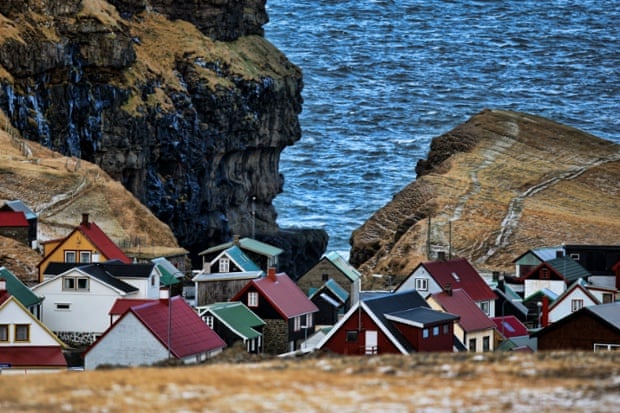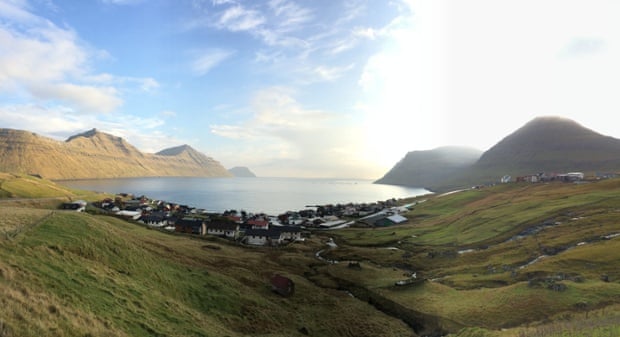This post may contain affiliate links. We may earn money or products from the highlighted keywords or companies or banners mentioned in this post.
It’s 4pm, shortly before dusk. Cupped in mountains, Sydrugöta is a cat’s cradle of streetlights beside a fjord turned to pewter in the fading light. Two teenagers lark in an outdoor hot tub, despite the November chill. Otherwise, the village is silent. You’d never guess it was about to host the first Hoyma music festival.
I’m trying to find Jón Tyril, the thirtysomething organiser who is also behind the larger, summer G! Festival. Look in the white house by the beach, they said. But there are five.
Should you ever wonder what makes the Faroese tick, knock on a few doors. No, the trick to house visits, I’m told at door three, is to tap briskly, pop your head in (no one bothers with locks) and shout “Hello”. To be at home in this remote Nordic archipelago is pretty much to have an open door to guests.
Hoyma is a bit like that. Instead of sound stages, 10 villagers will open their homes for the all-Faroese line-up – from an alt-folk duo and a classical guitarist to a Grammy-nominated singer and a reclusive folk hero. It is an anti-festival, Jón tells me. There are, he says, “no stages, no amps, no lighting, no security”.

Yet Hoyma – a phonetic rendering of the Faroese word for home, heima – taps deeper wellsprings of Faroese culture than that. When the Danish crown outlawed Faroese in 1538, the language went underground, preserved in stories and songs, and shared during the húsaganga – the tradition of “house-walking”, by which communities celebrated and endured long winters. “Faroese survived by us coming together, by sharing,” Jón says. “That’s what Hoyma is.”
Once derided as a backwater, the islands have flowered creatively, inspired by returning expats like Jón. Gudrun & Gudrun has made fishermen’s woollies high fashion – Sarah Lund’s The Killing jumper was one of theirs. Koks restaurant is at the vanguard of the new Nordic food movement, and Öström, a renovated warehouse in the capital, Tórshavn, is a showcase for Faroese designers.
Most visitors to the islands come to Tórshavn, a pocket-sized Reykjavik with Scandi design boutiques and Hobbity, grass-roofed restaurants serving astonishingly good fish, and warmly musty, air-dried lamb. But the point is to get out there: to walk, watch sea birds on the cliffs of Kalsoy, see the long house at Kirkjubøur that once housed Viking kings, or simply explore a winter landscape which carries a sense of immense, withheld power.

Photograph: lavur Fredriksen/PR
A few hours’ drive from Tórshavn I see a waterfall flow upwards, spun into the sky as vortices by the wind. At one point I punch through fog and seem to be aloft on a celestial highway. It feels less a road trip than a Viking saga.
Nor does winter mean darkness. Surrounded by empty ocean, the islands are illuminated by an ethereal light. The sun shoots above the horizon. The sea changes from indigo to slate, pewter, then silver within seconds. At night there’s the off-chance of seeing the northern lights.It’s not even that cold – the gulf stream maintains a winter average of 5C.
On a walk to the west of Vágar, I fall in with a farmer. Winter is his favourite time, he says, as we ascend: the nature, the colours, the rough seas. We crest the hill and the land vanishes into black cliffs where kittiwakes wheel. Ringed by mountains ahead is Gásadalur, a hamlet of 13 people, which teeters on a cliff by a waterfall, like a set from Game of Thrones.

Photograph: James Stewart
Back in Sydrugöta 11, Greta Svabo Bech (who won a Grammy nomination for work with dance music giant Dedmau5 ) sits on a stool lit by an Ikea lamp, and starts to sing – about captured spirits, lovesick trolls and departing soldiers. The sound is as haunting as the scenery outside.
For two hours I hop between living rooms. At 10pm, I’m in a stylish open-plan lounge to see Kári P. For your average Faroese he is Bob Dylan and Paul McCartney rolled into one, his ballads from the 1970s still ubiquitous on the radio. From elfin 18-year-olds to beer-swilling 60-somethings, the crowd picks up the tune; sotto voce at first, then swelling into the chorus.
Somewhere out there in the darkness are inhospitable mountains and seas that will freeze you to death in five minutes. But here we are, snug and warm, singing together. Hoyma sweet Hoyma.
• Trip provided by Visit Faroe Islands. Atlantic Airways (atlantic.fo) flies from several UK cities to Vágar via Copenhagen from about £250. For further information see visitfaroeislands.com. For details of next November’s festival, keep checking gfestival.com
Powered by WPeMatico











